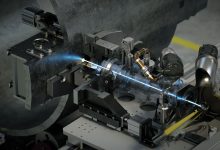EAP Technologies to Take Hybrid Electric Flight to New Heights
NASA has selected two U.S. companies to support its Electric Powertrain Flight Demonstration (EPFD) project that will rapidly mature Electrified Aircraft Propulsion (EAP) technologies through ground and flight demonstrations. Through the EPFD program, NASA seeks to introduce EAP technologies to U.S. aviation fleets no later than 2035, supporting short-range and regional commercial air travel, as well as single-aisle seat transports.
As part of NASA’s EPFD project, a total USD 260 million will be invested by NASA, GE Aviation and partners over five years to accelerate the introduction of hybrid electric flight technologies for commercial aviation. After years of maturing individual components of a hybrid electric system—motors, generators, and power converters—GE will systematically mature an integrated hybrid electric powertrain to demonstrate flight readiness for single-aisle aircraft.
The awards under the EPFD project announcement are hybrid firm fixed-price/cost-share. The companies that received awards and their award values are GE Aviation (GE) of Cincinnati, USD 179 million and MagniX USA Inc of Redmond, Washington, USD 74.3 million.
“By taking these concepts to flight, NASA and its partners will accelerate the transition of EAP technologies into commercial products and be a catalyst for economic growth,” said Robert Pearce, associate administrator for the Aeronautics Research Mission Directorate at NASA Headquarters in Washington. “We expect to realize significant improvements in the economic and environmental performance of subsonic transports through incorporation of these novel alternative propulsion and energy technologies into the fleet.”
Over five years, the selected companies will conduct ground and flight test demonstrations of their EAP technologies applicable to commercial aircraft transports. They will collaborate with other NASA projects on EAP development, flight test instrumentation, and data analysis. And they will stimulate spiral developments of megawatt-class EAP systems and technology.
“GE Aviation and MagniX will perform integrated megawatt-class powertrain system ground and flight demonstrations to validate their concepts, and project benefits for future EAP aircraft configurations,” said Gaudy Bezos-O’Connor, EPFD project manager at NASA’s Langley Research Center in Virginia. “These demonstrations will identify and retire technical barriers and integration risks. It will also help inform the development of standards and regulations for future EAP systems.”
The EPFD project is a part of NASA’s Integrated Aviation Systems Program (IASP) which conducts flight-oriented, system-level research and technology development to mature and transition advanced aeronautic technologies into future air vehicles and operational systems. IASP focuses on the execution of highly complex flight tests and related experiments to support all phases of NASA’s aeronautics research.
Reflecting on a recent visit to NASA, GE Aviation President and CEO John Slattery stated that decarbonizing aviation was “our industry’s moonshot.” Now GE engineers and the U.S. space agency get to work on the moonshot together.
“We are grateful for the opportunity to partner with NASA to take hybrid electric aircraft engines out of our test labs and into the sky, bringing more sustainable technology solutions to commercial aviation as quickly as possible,” said Mohamed Ali, vice president of engineering for GE Aviation.
Hybrid electric propulsion technologies that save fuel and optimize engine performance are key to GE’s commitment to help develop a more sustainable future of flight. Hybrid electric technologies are highly compatible with Sustainable Aviation Fuel (SAF) and hydrogen, as well as advanced engine architectures such as the open fan and new advanced engine core designs.
Last year, GE made a commitment to becoming carbon neutral in its own operations by 2030. In GE’s 2020 Sustainability Report, released in early July, the company went even further, with an ambition to reach net zero by 2050, including Scope 3 emissions from the use of sold products.
John Slattery recently pointed out that GE spent USD 1.8 billion in 2020 on aviation research and development, including new advanced materials and technologies that can help cut fuel consumption and enable hybrid electric design. One recent example is the CFM RISE Program, short for Revolutionary Innovation for Sustainable Engines. Announced in June by CFM International, a 50-50 joint company between GE and Safran Aircraft Engines, the technology demonstration program aims to improve fuel efficiency in new engines by more than 20% by the middle of the next decade. The project includes hybrid electric research.
Scientists at GE Research are also working with the U.S. Department of Energy’s Advanced Research Projects Agency–Energy (ARPA-E) division to design an electricity-driven propulsion system both powerful and light enough to keep aloft a 175,000-pound commercial airliner and its 175 passengers.







